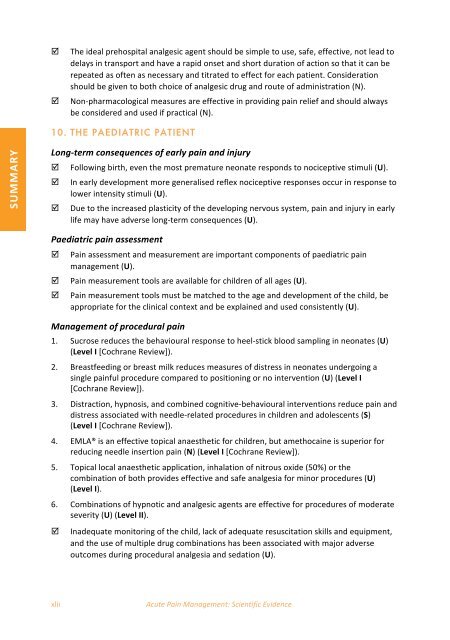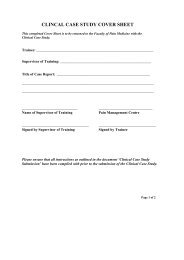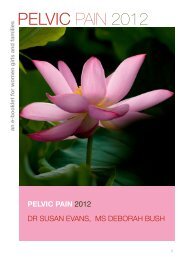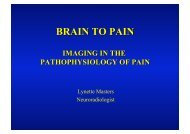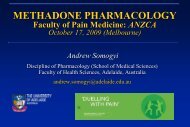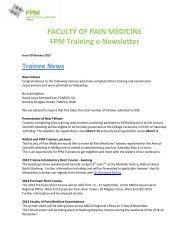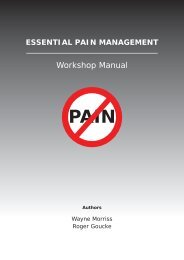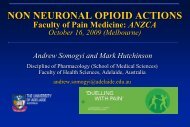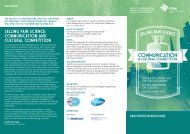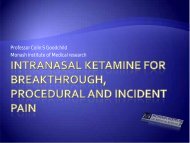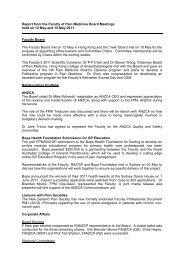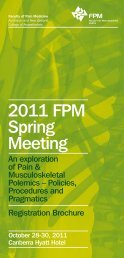Acute Pain - final version - Faculty of pain medicine - Australian and ...
Acute Pain - final version - Faculty of pain medicine - Australian and ...
Acute Pain - final version - Faculty of pain medicine - Australian and ...
You also want an ePaper? Increase the reach of your titles
YUMPU automatically turns print PDFs into web optimized ePapers that Google loves.
<br />
<br />
<br />
<br />
The ideal prehospital analgesic agent should be simple to use, safe, effective, not lead to <br />
delays in transport <strong>and</strong> have a rapid onset <strong>and</strong> short duration <strong>of</strong> action so that it can be <br />
repeated as <strong>of</strong>ten as necessary <strong>and</strong> titrated to effect for each patient. Consideration <br />
should be given to both choice <strong>of</strong> analgesic drug <strong>and</strong> route <strong>of</strong> administration (N). <br />
Non‐pharmacological measures are effective in providing <strong>pain</strong> relief <strong>and</strong> should always <br />
be considered <strong>and</strong> used if practical (N). <br />
10. THE PAEDIATRIC PATIENT<br />
SUMMARY <br />
Long‐term consequences <strong>of</strong> early <strong>pain</strong> <strong>and</strong> injury <br />
<br />
<br />
<br />
Following birth, even the most premature neonate responds to nociceptive stimuli (U). <br />
In early development more generalised reflex nociceptive responses occur in response to <br />
lower intensity stimuli (U). <br />
Due to the increased plasticity <strong>of</strong> the developing nervous system, <strong>pain</strong> <strong>and</strong> injury in early <br />
life may have adverse long‐term consequences (U). <br />
Paediatric <strong>pain</strong> assessment <br />
<br />
<br />
<br />
<strong>Pain</strong> assessment <strong>and</strong> measurement are important components <strong>of</strong> paediatric <strong>pain</strong> <br />
management (U). <br />
<strong>Pain</strong> measurement tools are available for children <strong>of</strong> all ages (U). <br />
<strong>Pain</strong> measurement tools must be matched to the age <strong>and</strong> development <strong>of</strong> the child, be <br />
appropriate for the clinical context <strong>and</strong> be explained <strong>and</strong> used consistently (U). <br />
Management <strong>of</strong> procedural <strong>pain</strong> <br />
1. Sucrose reduces the behavioural response to heel‐stick blood sampling in neonates (U) <br />
(Level I [Cochrane Review]). <br />
2. Breastfeeding or breast milk reduces measures <strong>of</strong> distress in neonates undergoing a <br />
single <strong>pain</strong>ful procedure compared to positioning or no intervention (U) (Level I <br />
[Cochrane Review]). <br />
3. Distraction, hypnosis, <strong>and</strong> combined cognitive‐behavioural interventions reduce <strong>pain</strong> <strong>and</strong> <br />
distress associated with needle‐related procedures in children <strong>and</strong> adolescents (S) <br />
(Level I [Cochrane Review]). <br />
4. EMLA® is an effective topical anaesthetic for children, but amethocaine is superior for <br />
reducing needle insertion <strong>pain</strong> (N) (Level I [Cochrane Review]). <br />
5. Topical local anaesthetic application, inhalation <strong>of</strong> nitrous oxide (50%) or the <br />
combination <strong>of</strong> both provides effective <strong>and</strong> safe analgesia for minor procedures (U) <br />
(Level I). <br />
6. Combinations <strong>of</strong> hypnotic <strong>and</strong> analgesic agents are effective for procedures <strong>of</strong> moderate <br />
severity (U) (Level II). <br />
<br />
Inadequate monitoring <strong>of</strong> the child, lack <strong>of</strong> adequate resuscitation skills <strong>and</strong> equipment, <br />
<strong>and</strong> the use <strong>of</strong> multiple drug combinations has been associated with major adverse <br />
outcomes during procedural analgesia <strong>and</strong> sedation (U). <br />
xlii <br />
<strong>Acute</strong> <strong>Pain</strong> Management: Scientific Evidence


